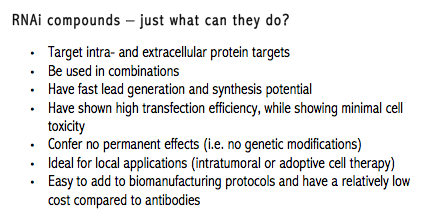Running interference
23 Apr 2019 by Evoluted New Media
Immuno-Oncology is considered a vital front in the battle against cancer, but will current approaches get us there? Dr Geert Cauwenbergh takes us through some pitfalls and tells us how RNA interference therapies are a promising alternative...
The history of cancer therapy started several centuries ago, with surgery as the primary treatment, followed by radiotherapy in the 1890s, traditional chemotherapy in the 1940s and more recently precision therapy (1980s) and immunotherapy (1990s).
With immunotherapy, after decades of very slow progress in the treatment of cancers, a shift has taken place in the thinking of scientists and doctors. This has resulted in more focus on optimising the immune system and immune effector cells as the primary fighters against tumor growth and metastasis, rather than providing toxic cell substances to the whole body often resulting in significant side effects.
Cancer immunotherapy can be classified in terms of the desired mechanism of action of the treatment. The desired effects can be put in three categories: to boost the immune effector function, to boost effector cell fitness and persistence and to increase tumor cell recognition and susceptibility to the immunotherapy.
There are really three main drugs and therapeutic approaches taken in the field of immuno-oncology.
Antibodies
Initially, most anti-cancer antibodies focused on blocking receptors involved in cell growth and survival – overexpressed on certain tumors – and on inducing antibody dependent cell cytotoxicity. Current examples of such available cancer immunotherapies are Herceptin and Avastin. More recently, antibodies against immune checkpoints have been playing an increasingly important role in immunotherapy. The antibody checkpoint inhibitors have shown impressive results in patients with specific solid tumors (e.g. stage 4 malignant melanoma), where five-year survival rates of patients have increased from less than five percent to more than 20 percent.
RNAi can ‘silence’ or downregulate, the expression of a specific gene that may be overexpressed in a disease condition
Examples of antibody-based immune checkpoint blockade products include Keytruda and Yervoy. One of the limitations of antibody therapy is that they can only block extra-cellular epitopes. In addition, in cancer several targets often need to be blocked at the same time, and it has been shown difficult to use antibody combinations without significant side effects. Also, antibodies come at a high cost and long production time and may have undesired side effects.
It is becoming clear that other approaches to block proteins and signal transduction are needed. Additionally, finding ways to combine several targets at once, including intracellular targets, will be necessary to further improve upon current therapeutic options with antibodies.
Small molecules Small molecules, on the other hand, can act on intracellular targets and receptors affecting immuno-modulatory pathways in cancer. In addition, they have the potential for higher tissue and tumor penetration. Unfortunately, small molecules are not very selective. In contrast to antibodies, the activity of small-molecule drugs is seldom limited to one specific protein target or a single aspect of a targeted signal transduction. This means that they can cause off-target side effects, often caused because they target molecular biological pathways that are essential for cell or organ function. In addition, cancer cells are known to develop resistance against them over time. Last but not least, the discovery research and lead optimisation timeline of small-molecule drugs is often much longer than those for biotechnology approaches to new drugs.
Gene engineering and editing Using gene engineering has been proven feasible in the field of adoptive cell transfer, or ACT. In ACT, immune cells are isolated from patients or retrieved from allogeneic sources. The immune cells are then expanded and modified before being returned and used to treat the same patient. Using gene editing, immune effector cells can be programmed to recognise certain tumor-specific antigens and to be more active. CAR-T cells, a type of genetically engineered T cell, have been recently approved (Kymriah and Yescarta) and have gone on to confer spectacular survival results in patients with late-stage hematological malignancies.
 Their effectiveness as a monotherapy in solid tumors is, however, limited. In addition, engineered cell manufacturing is subject to a high degree of complexity, making it a rather expensive alternative. Using gene editing techniques, one can change the genetic code of an existing gene to produce a phenotypic effect. Similar to antibodies, utilising gene editing techniques it is difficult to modify or target multiple genes of interest at the same time.
Their effectiveness as a monotherapy in solid tumors is, however, limited. In addition, engineered cell manufacturing is subject to a high degree of complexity, making it a rather expensive alternative. Using gene editing techniques, one can change the genetic code of an existing gene to produce a phenotypic effect. Similar to antibodies, utilising gene editing techniques it is difficult to modify or target multiple genes of interest at the same time.
Finally, the more gene engineering or editing is required, the larger and more complex the gene constructs become, with increased uncertainty of long-term genotypic and phenotypic effects by inducing potential undesired permanent genetic modification.
Another way… A novel approach that combines several of the advantages of the therapeutic approaches mentioned above, without their disadvantages, is RNAi technology.
RNAi was first discovered by Andrew Fire and Craig Mello in 1998, who both later received the 2006 Nobel Prize in Physiology or Medicine for their work on RNA interference. RNAi could become a great tool to offset some of the shortcomings of the aforementioned approaches. Indeed, RNAi can ‘silence’ or downregulate, the expression of a specific gene that may be overexpressed in a disease condition.
Many of the challenges surrounding RNAi relate to delivery to the cell, which has shown to be difficult to overcome and thus far have limited its use in immuno-oncology. However, by building chemical modifications into the RNAi molecule, Phio Pharmaceuticals developed self-delivering RNAi (sd-rxRNA). These RNAi compounds do not require a delivery vehicle to penetrate the cell. The self-delivering RNAi compounds can target – with high specificity and potency – specific mRNA sequences, whether intracellular or extracellular, leading to reduction of corresponding protein levels.
Therefore, these compounds have the potential to play a vital role in boosting the immune effector cell function, fitness and persistence, and increasing tumor cell recognition and susceptibility. Moreover, the compounds may be ideally suited to be used in combination with ACT in order to make these immune cells more effective.
The treatment of the immune cells with the sd-rxRNA compounds during the expansion and modification phase can be achieved by merely adding these compounds to the cell culture media used during the cell expansion. As it does not require a delivery vehicle or electroporation to penetrate into the cells, the desired cell modification can be achieved without the potential negative effects of the delivery methods required for conventional RNAi molecules.
This new approach has shown promising preclinical effects on selective knockdown of the target proteins, for example, by inhibiting the expression of immune checkpoint genes. This has shown to result in boosting the killing effects of the immune effector cells, including tumor-infiltrating lymphocytes and natural killer cells, that were transfected with sd-rxRNA.
The first lead candidate of this novel class of immunotherapy compounds from Phio is expected to enter into clinical development in the next 12 to 18 months.
Author:
 Dr Geert Cauwenbergh is the former CEO of Phio Pharmaceuticals, a biotechnology company developing the next generation of immuno-oncology therapeutics]. He currently sits on the Board of Directors.
Dr Geert Cauwenbergh is the former CEO of Phio Pharmaceuticals, a biotechnology company developing the next generation of immuno-oncology therapeutics]. He currently sits on the Board of Directors.









